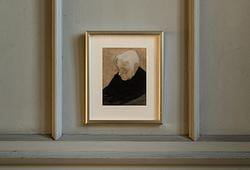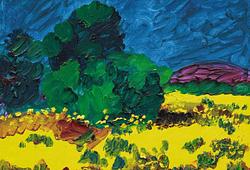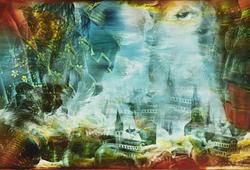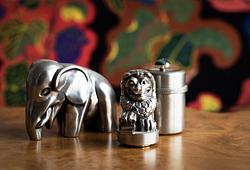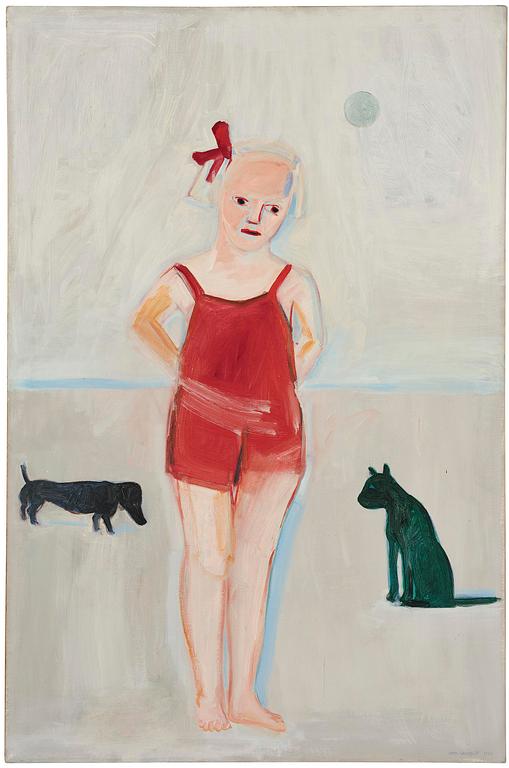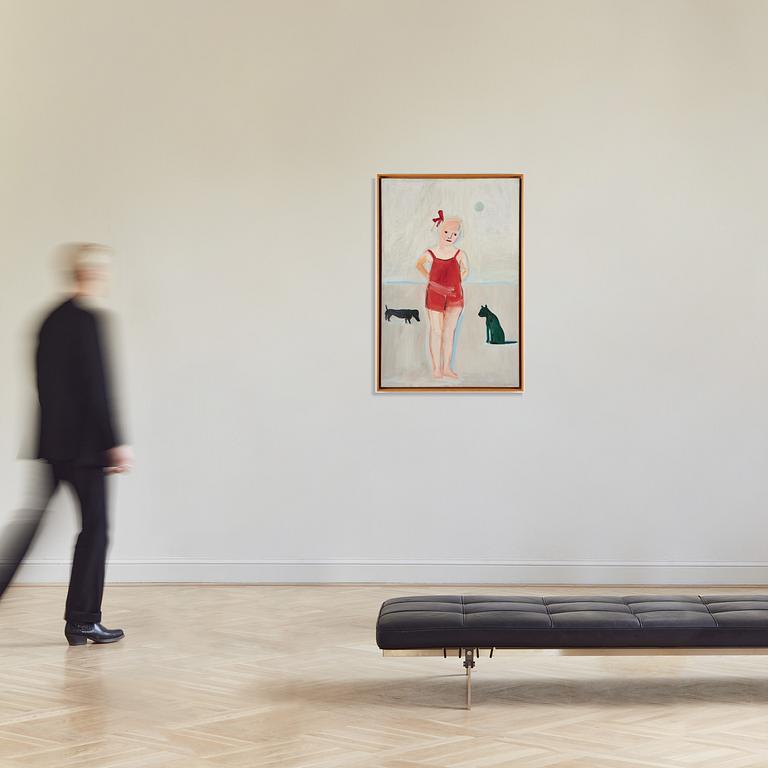Lena Cronqvist
"Vilken hand?"
Signed Lena Cronqvist and dated 1990. Tempera and oil on canvas 136 x 90 cm.
Provenance
Galleri Lars Bohman, Stockholm.
Bukowski Auktioner, Contemporary Art & Design, 27 April 2004, lot 477.
Christies, London, Nordic Art and Design, 26 June 2007, lot 114.
Acquired from the above by the present owner.
Exhibitions
Gallery Lars Bohman, Stockholm, 1991.
Värmlands Museum, Karlstad, "Lena Cronqvist - Retrospective Exhibition", 18 January - 1 March 1992, cat. no 25.
Liljevalchs konsthall, Stockholm, "Lena Cronqvist", 2 September - 16 October 1994, cat. no 180.
Konsthallen, Gothenburg, "Lena Cronqvist", 22 October - 10 November 1994.
Malmö Konstmuseum, "Lena Cronqvist", 27 September 2003 - 18 January 2004.
Tikanoja konsthem, Vaasa, Finland, "Lena Cronqvist", 8 February - 21 March 2004.
Munch Museum, Oslo, "Head by Head", 28 October 2017 - 28 January 2018.
Prins Eugens Waldemarsudde, Stockholm, "Lena Cronqvist" 7 May - 29 September, 2020, cat. no 68.
Literature
Ingela Lind (ed.), "Lena Cronqvist, Målningar 1964-1994", illustrated full page p. 161, also cover image.
Mårten Castenfors, "Lena Cronqvist", 2003, illustrated full page p. 91.
K. Macleod, "Lena Cronqvist: Reflections of Girls", 2006, illustrated p. 63.
Karin Sidén och Catrin Lundeberg (ed.), "Lena Cronqvist", Prins Eugens Waldemarsuddes utställningskatalog 135:20, 2020, illustrated.
More information
In a period when many artists were breaking away from traditional representation—driven above all by the American currents of Abstract Expressionism and Pop Art—Lena Cronqvist chose a different path. She remained committed to figuration and to a deeply personal subject matter, an approach she has sustained throughout her career.
Her hallmark style consists of full-length depictions of children, most often young girls, whose seemingly playful scenes conceal unsettling, sometimes grotesque undertones. In numerous works the children interact with dolls that serve as stand-ins for their parents. At times these appear in innocent, dollhouse-like role reversals that destabilize familial hierarchies; in other instances, the dolls are subjected to violent or sexually charged acts. These images confront the anxieties and struggles of growing up—concerns that later re-emerge in Cronqvist’s self-portraits as an older woman, where the tension shifts from childhood to the realities of aging. The dynamic has reversed: now it is the girls who resemble dolls, subject to her control in gestures marked by both urgency and release.
Vilken hand? (Which Hand?) revisits Cronqvist’s autobiographical reflections on childhood. The composition is stripped down, yet its atmosphere is heavy with intensity. A solitary girl stands on a beach, her face unusually pensive and tinged with sadness for her age. Her features recall photographs of Cronqvist herself as a child, and reappear throughout her work in the recurring figure of the elder sister. The painting’s title alludes to a hidden choice: the girl clasps something in each hand behind her back, offering the unseen counterpart before her only one. Could these be the parental dolls so central to Cronqvist’s imagery? Despite the presence of a cat and a dog, the child’s solitude and melancholy imbue the picture with existential gravity. It remains one of Cronqvist’s most emblematic works—at once restrained and charged, rooted in personal memory yet resonating on a universal level.
Artist
Lena Cronqvist is born and raised in Karlstad. Her interest for the arts came early in her life, and she spent the first year of her studies in England, near Bristol’s Art School. Upon her arrival back in Sweden, Cronqvist began a short-lived education at Konstfack, leaving to study painting at the Royal Academy of Fine Arts. When examining Lena Cronqvist's painting, it delves into "painting" in its more traditional sense. She is indeed a painter in the grand modern tradition, frequently turning to Edvard Munch and Francis Bacon’s art as inspirational sources. Yet she also had numerous art historical references and a deep love for the craft. Cronqvist excelled as a colourist, finding harmony in the most unusual colour combinations – few have managed to paint warmth and cold successfully at the same time. Her subject matter is often perceived as challenging and overly private by many. She often models herself for her art, posing in mundane situations imbued with a sharp psychological character. Her “Modonna-pictures” from the 1970s are a good example of this. She turns our gaze away from the conventional, notably in her portrayal and depiction of girls, which is fascinating. Cronqvist depicts these girls as ugly, simple, and altogether uncomfortable – a great contrast to how woman were normally portrayed in art. In more recent years, Lena Cronqvist has studied the effect of aging, using herself as a study. Moreover, Cronqvist is a very successful sculptor, and several of her works in bronze have been sold great sums in the auction world. She is also gifted in graphic productions, of which “Strindbergsmappen” is the most well-known. Among her most renowned works is "The Betrothal," a paraphrase of Jan van Eyck's symbol-laden painting "The Arnolfini Portrait." In Cronqvist's reinterpretation, artist and husband Göran Tunström are the main characters, with equally weighty symbolism but carrying entirely different meanings. Where van Eyck's painting features a loyal dog, Cronqvist replaces it with a cat—a symbol of independence.
Read more



